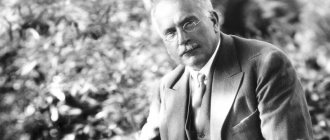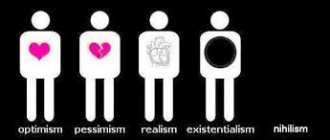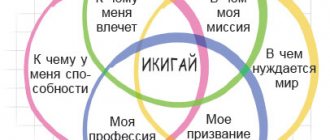The Rorschach test (Rorschach blots) is a psychological projection test containing 10 printed cards (5 black and white, 5 color). It was created in 1921 and published by psychologist Hermann Rorschach in the journal Psychodiagnostik. During the 1940s and 1950s, this test was integrally associated with clinical psychology. During much of the 20th century, the Rorschach test was very common and a well-interpreted psychological test. For example, in studies from 1947 (Louttit and Browne) and 1961 (Sundberg), it was ranked as the fourth and first psychological test, respectively, in terms of frequency of use.
Despite its widespread use, the Rorschach test has been associated with a large number of controversies. Researchers have often had difficulty studying the test and its results systematically, and the use of several different scoring systems for the responses given to each image has created some confusion.
"Rorschach stains" or a test for psychopaths
Life is a hall of mirrors, an amalgam, a Rorschach test, you see in it only what is inside you.
Al Quotion. Collocation
- 1.The Story of Rorschach
- 2.Scoring systems in the Rorschach test
- 3.What does the Rorschach test measure?
- 4.How is the Rorschach test performed?
- 5.Rorschach test evaluation
- 6. Pictures of Rorschach “blots”
- 7. Interpretation of the Rorschach test
- 8. Rorschach test: opinion of foreign psychologists 8.1. What do you see? The answer will tell you a lot about you!
- Only introverts can see these hidden images, thanks to their unique powers of observation.
- Introvert - who is it? The whole truth about introverts
- "Rorschach stains" or a test for psychopaths
- Who do you see first? Your answer will show your personality!
- Psychology of color: How each color characterizes personality
The Story of Rorschach
Hermann Rorschach never told anyone how he came up with the idea for the test.
However, like many figures of that time, he often played the popular game Blotto (Clexography), in which associations associated with poetry are selected or charades are created using inkblots. Cards with such ready-made inkblots could be easily purchased in stores at that time. In addition, his close personal friend and teacher Konrad Goering could have suggested using these spots as a psychological tool.
When Eugen Bleuler coined the term "schizophrenia" in 1911, Rorschach became interested in the topic and wrote a dissertation on hallucinations (Bleuler was Rorschach's dissertation chairman). While working with patients suffering from schizophrenia, Rorschach accidentally discovered that they reacted differently to Blotto's game than other people.
He gave a brief presentation about his discovery to the local psychiatric society, but then that was the end of it. It was only after he opened a psychiatric practice at the Russian Crombaz hospital in Herisau in 1917 that he became interested in systematically studying the Blotto game.
In his studies from 1918 to 1921, Rorschach used about 40 inkblots, but only 15 of them were regularly used on his patients. Ultimately, he collected data from 405 subjects (117 were not his patients, and he used them as a control group).
His method of evaluation did not emphasize the content of the answers, but rather the classification of the answers according to their various characteristics. To do this, he used a set of codes - today called ratings - to determine whether the answer applied to the entire image (W), to a large part of it (D), or to a smaller detail. A score of F was used for a response related to the shape of the detail of the spot, and a score of C indicated that the color of the spot was included in the response.
In 1919-1921 he tried to find a publisher to publish his discoveries and the regularly used 15 inkblot cards. However, all publishers refused to publish all 15 stain images due to the cost of printing. Finally, in 1921, he found a publisher - House of Bircher - willing to publish his spots, but only 10 of them. Rorschach revised his manuscript to include only the 10 most commonly used blots out of 15.
Alas, the print was not of high enough quality to correctly convey the original stains. The original Rorschach blots had no halftones—they were pure colors. Reproducing them in print added nuance. But rumor has it that Rorschach was quite pleased with this new addition to his stains. After publishing a monograph entitled Form Interpretation Test, he died in hospital in 1922 due to abdominal pain. Rorschach lived only 37 years, and he formally worked on his inkblot tests for only four years.
Childhood
At first, Hermann Rorschach attended a public school, and after graduating he moved to a cantonal school. It was distinguished by a higher level of training and better teaching staff. In all subjects, Herman showed equally high results. He was a well-bred and diligent young man.
When Rorschach was 12 years old, his mother died. The housekeepers now took care of the boy, as well as Herman's brother and sister. Two years later, Ulrich married a distant relative of his deceased wife named Regina. She was an energetic and skillful woman, but Herman never managed to find a common language with her. In 1903, Ulrich died of an incurable disease. Herman had only 12 months left before graduating from cantonal school.
Scoring systems in the Rorschach test
Until the 1970s, there were five main systems for rating the responses given by people who see these spots.
Among them, two systems dominated - the Beck and Klopfer systems. The other three systems were used less frequently. These were the systems of Hertz, Piotrovsky and Rapaport-Shafer. In 1969, John E. Exner, Jr. published the first comparison of these five systems, entitled The Rorschach Systems. The revelation of Exner's stunning analysis was that there were, in fact, no five grading systems for Rorschach blots. Exner concluded that these five systems differed from each other so greatly and significantly that it could be considered that five different “Rorschach tests” were created. It's time to go back to the drawing board. Following his alarming discovery, Exner set out to create a new, comprehensive Rorschach scoring system that would combine the best components of these five existing systems, complemented by extensive empirical research on each component.
The work began in 1968 and included important research into creating a new system for rating Rorschach blots. As a result, in 1973, Exner published the first edition of The Rorschach: A Comprehensive System. In this work, he introduced a new scoring system that became the new gold standard (and the only scoring system taught to psychologists today).
Personal life
After finishing his studies, the young doctor was faced with a choice: get a job at a university clinic and receive a meager salary or go to a cantonal hospital, where the salary was much higher. Also in 1909, Hermann Rorschach announced his engagement to Olga Stempelin (he met the girl while studying in Russia). The young family needed money, so the hero of this article chose a cantonal psychiatric hospital. It was located in Müsterlingen, on the shores of the picturesque Lake Baden. Rorschach moved there with Olga.
There were 400 patients in the clinic. And the medical staff consisted of only three people - the chief physician and two assistants. There were no social workers or secretaries, so the duties of the assistants included making rounds of departments, morning planning meetings, and organizing various events for patients. After completing their duties, the assistants had free time to go boating, swim in the lake, or do other things.
Rorschach spent four years in Müsterlingen. Perhaps this was the happiest period in his life. In 1910 he married Olga. The wedding took place in Geneva, in the Russian Orthodox Church. Later, the wife gave birth to two children to the psychiatrist.
What does the Rorschach test measure?
The Rorschach blot test was not originally intended to be a projective measure of personality characteristics.
Instead, he had to construct a personality profile of a person with schizophrenia (or another mental disorder) based on frequency ratings. Rorschach himself was skeptical about using his test to projectively measure personality characteristics.
The Rorschach test, at its most basic level, is a task that provides a reflection of the psychology of the person taking the test, as well as establishing some level of understanding of the patient's past and future behavior.
Patients often use imagination to formulate an answer, but the underlying process of solving this problem has little to do with imagination or creativity.
Card 5
People usually see a bird, bat or butterfly . These so-called “standard answers” speak of mental stability and a healthy imagination.
If you see the faces of crocodiles , negative feelings and hostility prevail in you.
If you see scissors, it could mean that you are afraid of being vulnerable or defenseless.
How is the Rorschach test performed?
The person taking the test is given a card with a spot printed on it and asked, “What could it be?” Responses are usually recorded verbatim (today recording devices are used for this) because they will later be assessed by a psychologist.
Exner divided the subject's answer to the question of what is shown on the map into three primary phases:
- In phase 1, while a person is looking at the map, his brain is encoding the stimulus (the spot) and all its details. It then categorizes the stimuli and their parts, and the brain develops an informal ordering (ranking) of possible responses.
- In phase 2, the person discards possible answers that have a low rank and checks the remaining answers that seem suitable to him.
- In Phase 3, the person selects some of the filtered responses based on characteristics, styles, or other sources of influence.
If a person reacts to the general contours of the spot, then, according to Exner, there is a slight projection. However, when the subject begins to embellish his answer, or adds more information than was originally given to him, this may be a sign of projection occurring at the moment. In other words, a person tells the psychologist something about himself, or about his life, because he goes beyond the characteristics of the spot itself.
Mirror reflections are not much different from Rorschach tests - by looking at them, we become a victim of our own myopia or our fears. Ray Bradbury. Midnight Dragon Dance
After the patient goes through all ten spots for the first time and tells the psychologist what he sees in each spot, the psychologist should again offer each spot to the person, asking the person taking the test to help the psychologist see what the person saw when he first answered. It is here that the psychologist receives certain details for a clearer understanding of what different aspects and where exactly the subject saw in each spot.
Reviews and comments
You can share and discuss your results using the comment form below.
We also recommend reading:
- Storytelling
- Koos Cubes
- Luscher test
- Szondi test: how to identify mental disorders by appearance?
- Roger Shepard test
- Artificial Intelligence and the Turing Test
- Visuospatial Corsi test: description and application
- Types of tests and their features
- Japanese system of intelligence development
- Eysenck test: what does your IQ tell you?
- Wechsler test
Key words: 1Psychoregulation, 1Self-knowledge
Rorschach test score
Scoring the Rorschach test is a very complex task that requires good preparation and experience in administering the test.
Only professional psychologists are properly trained and have the experience necessary to correctly interpret the results. Thus, any “Rorschach test” that you can take online on the Internet, or that is performed/interpreted by a specialist in another discipline, may produce unreliable results or be of little benefit.
Exner's scoring system checks every aspect of an answer, from how many spots are used, to what history is associated with the answer (if provided by the answerer), to the level of detail and type of content of the answer. The assessment begins by examining the quality of the response's elaboration—in other words, how well it is constructed and whether the response is routine, vague, or arbitrary.
The basis of evaluation is related to the encoding of the response in accordance with all the characteristics of the spot that are involved in the formation of the response.
The following characteristics are encoded:
- Form.
- Movement - whether movement appears in the response.
- Chromatic color is when the answer uses color.
- Achromatic color - when the answer uses only black, white, or gray.
- Halftone Texture - When a response uses texture.
- Halftone dimension - when the answer uses dimensions related to halftones.
- Halftone scattering is when halftones are used in the answer.
- Shape dimensions - when the answer uses dimensions other than halftones.
- Pairs and reflections - when the answer uses pairs or reflections.
Because many people give complex and detailed answers to the question of what they see in spots, the scoring system uses the concept of “mixtures” to account for complex answers.
These mixtures take into account multiple objects or the method used to describe an object. Organizational response activity assesses how well the response is organized. Finally, it evaluates shape quality—that is, how well the answer matches the spot itself (depending on how the person taking the test describes it). If the spot looks like a bear, and the person describes it as a bear, then it may have an "ordinary" form quality - quite acceptable, but not showing much creativity or originality.
There are, of course, many popular responses to spots that resemble real-life objects or creatures. The Exner scoring system takes this into account by providing extensive tables for each card containing common responses and how they can be coded.
Parents
The Rorschachs were part of a community in the small town of Arbon in northern Switzerland. Herman's ancestors did not leave her for several centuries. His father Ulrich was the first to break tradition. In 1882, he married Philippine Wiedenkeller and left his hometown two years later.
First they went to Zurich. But after the birth of Hermann (in 1884), the Rorschach family moved to the city of Schaffhausen. Ulrich worked as a decorative artist, but the work did not bring him satisfaction. Therefore, Rorschach Sr. continued his studies at the school of applied arts. He was a gifted draftsman and often captivated children with the stories he depicted on paper. In 1886, Ulrich was hired as a painting teacher at the Schaffhausen College and School. He was a witty conversationalist, a caring husband and a kind man. His wife Philippine had the same qualities.
Pictures of Rorschach "blots"
Card 7
This is the so-called "mother card" and your reading shows your relationship with your mother or other significant women in your life.
If you see two women sitting (or standing) peacefully and talking , this indicates your healthy relationship with the female gender.
However, if you see two angry and quarreling figures , you either tend to look at women with contempt, or you have unresolved problems in your relationship with your mother.
Interpretation of the Rorschach test
After the responses to each card are correctly coded by the psychologist, an interpretive report is formulated based on the response ratings.
This report combines the results obtained from all test answers so that the combined answer cannot distort the test results. First, the psychologist checks the adequacy of the test, resistance to stress, and the amount of resources available to the person taking the test, comparing them with the requirements imposed on the patient at this time.
Next, the psychologist must examine the individual's cognitive functioning, accuracy of perception, flexibility of ideas and attitudes, ability to calm and control one's emotions, goal orientation, self-esteem and interests, as well as the relationship of these aspects with others.
There are also a number of less frequently used special indices to determine suicidal tendencies, depression, schizophrenia and other disorders. Typically, all of this can be more quickly assessed during a clinical interview, but the Rorschach test can help identify areas of concern in the patient when some questions remain.
Card 1
Most often people see a butterfly, bat or moth . These options indicate a stable emotional state and healthy self-esteem.
Someone may see a wolf's muzzle or a scary face , and this serves as an indicator of a depressive state.
Some people see an angel with outstretched wings, indicating their calm and carefree nature.
If you see two animals or two figures attached to a third figure in the center, this may mean that you sense some kind of threats around you.
Rorschach test: opinion of foreign psychologists
What do you see? The answer will tell you a lot about you!
For decades, the Swiss psychiatrist's Rorschach test, created in 1921, has helped decipher the workings of the human mind.
But now the secret has been revealed, and psychiatrists are outraged by it. The test was carried out on an ink pattern on 10 standard sheets of paper: ink was dropped onto the sheet, then it was folded in half and straightened out - a symmetrical picture appeared. The images were black and white, red and white, or multicolor. The test taker had to say what it looked like - the first thing that came to mind.
Some saw a pair of dancing wolves, others saw a butterfly or human pelvic joints. The psychiatrist gained insight into his patients based on whether they responded to shape and color or whether they saw only the whole image. The test participant explained his reaction to each pattern. Based on what was said, a picture of the work of his brain was constructed, and conclusions were drawn about the patient’s condition.
James Heilman, an emergency physician from Canada, posted 10 ink images of Hermann Rorschach on Wikipedia. He accompanied the pictures with the most common reaction to them, angering the psychiatry community. Critics compared the publication to the premature release of answers to exam questions, destroying the psychiatric test. James Heilman explained his provocation by the need to lift the ban on discussing the topic - from that moment the debate began.
Psychologists were concerned because the information appeared on the popular Wikipedia, believing that the more material was published, the more meaningless the test results became. Some doctors believe that the test helps the patient open up during a psychoanalytic session, but it has ceased to be the main psychological method.
Psychiatrist Tony Black practiced in the highly secure British Broadmoor prison and used the Rorschach test, but he was not happy with the results. Today he is skeptical of the test because modern surveys and interviewing techniques have little room for physician intuition.
The Wikipedia website says that the 10 ink images have been published previously in several publications and that they are in the public domain in Hermann Rorschach's homeland of Switzerland, as well as in the United States. Moreover, it is unknown how easy it is to study an inkblot and fool a psychiatrist.
Card 2
If you see two identical figures sitting opposite each other, you have a harmonious relationship with others.
If you notice two people fighting, or you perceive the color red as blood, this indicates the suppression of aggression in yourself.
Some studies have shown that people who see two clowns are prone to narcissism.









